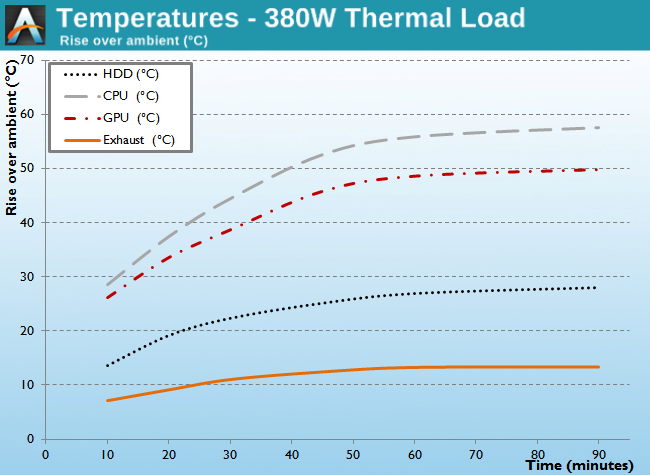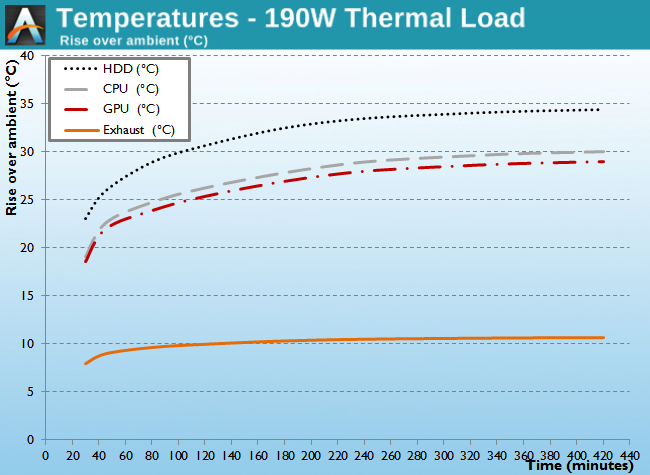The Cougar QBX Mini ITX Case Review
by E. Fylladitakis on November 13, 2015 8:00 AM EST- Posted in
- Cases/Cooling/PSUs
- Mini ITX
- Cougar
- Case
Test Setup
Professional testing requires the emulation of real-world situations but with repeatable results; thus, a perfectly controllable test setup and environment are required, especially for comparable results. Testing the thermal performance of any case with a typical real-world setup technically limits the comparability of the results to this setup alone, as an active system interacts with its environment and the change of a single component would alter myriads of variables.
For that reason we have developed synthetic loads that emulate the thermal output of real systems, allowing us to test with a passive, steady, and quantifiable thermal load. As such, the thermal testing now displays the thermal capabilities of the case alone, as if it would have to deal with the entire thermal load by itself, regardless of the system that would be installed inside it. Laboratory data loggers are being used to monitor the PT100 sensors and control the safety relays, which are fully accessible via our custom software. The Mini-ITX version of our thermal load simulates a 150 W CPU, 30 W VRM, 20 W RAM and 1 × 120 W GPU card thermal load. For low-profile card setups, we are using a 50 W dummy GPU card instead. Finally, 2.5" and 3.5" HDD dummy loads have also been created, which produce 15 W and 30 W of heat respectively. Overall this setup allows us to scale the total thermal load over a wide range from low to high, and at the highest load only the best of cases will be able to handle it for more than a few minutes.
For the full power test we are using the aforementioned configuration, with the full-size 120W PCIe card plus one 3.5" load and two 2.5" loads. The low load test reduces the main system's power output down to about 42% (132 Watts total), but the disk loads remain unchanged.
Noise testing has been performed with a background noise level of 30.4dB(A). Advanced noise testing is also being performed in order to assess the ability of the case to dampen the noise of the components installed inside it. This includes the installation of two noise-generating sources (strong fans) inside the case, with one positioned roughly over the first expansion slot while the other is over the CPU area, which combined generate ≈ 44.2 dB(A) of noise when unobstructed. During the advanced noise test, all stock cooling options for the case are disabled.
Results & Discussion
Unfortunately we've only used the latest iteration of our case tests on a handful of Mini-ITX cases, so we cannot make extensive comparisons. That said, we can easily determine that the thermal performance of the Cougar QBX is significantly better than that of very small ITX cases, such as the SilverStone Milo ML05, as the QBX has both superior cooling and over twice the size. Even with the slow stock 92 mm fan, the QBX appears to be capable of maintaining reasonable operational temperatures with a 380 Watt thermal load inside.
Still, the design of the QBX is not without it weak points. Our test results clearly reveal that the drive cage receives little-to-no additional cooling with just the stock 92 mm fan installed. The drawback becomes especially apparent with our 190W thermal load. In the 190W scenario the drive cage runs some 4 degrees warmer than the CPU despite the significantly smaller thermal load in the drive cage. This is not a major issue since modern drives can put up with this temperature, but it's perhaps not the best environment for a HDD that's constantly writing (e.g. video surveillance).
The stock 92 mm fan may not remove a ton of heat on its own, but at the same time it's a very quiet model that remains practically inaudible. Even at its maximum speed, the maximum sound pressure of 35.2 dB(A) is very low and barely noticeable. At those levels the case fan noise will almost certainly be overcome by the noise from the rest of the system, which unfortunately doesn't get dampened much before reaching the user. Due to the many openings in the case, especially to its sides, the Cougar QBX has very limited sound dampening capabilities. With our dummy noise source inside the case we recorded 41.9 dB(A) of noise from the outside. The difference of 2.3 dB(A) is measurable and perhaps noticeable by some people, but only just. Practically speaking I don't expect very many users to pick up on such a small increase.













42 Comments
View All Comments
SpartyOn - Friday, November 13, 2015 - link
I like the exterior look of this case and will definitely keep an eye on it, but I think for practicality purposes, I'll have to stick with my Cooler Master 120. The Cougar just looks a little big for my tastes in the wrong dimension (too tall).Before Cooler Master released the 130 without the drive rack (though by the looks of the 130, the cage maybe would still take some modding) I modded the CM 120 by removing the internal bays and mounting two 120x120x52mm CLCs in it with three 120mm fans in a stacked rad configuration (F-R-F-R-F), one for the GPU and one for the CPU. The overclocked CPU gets the fresh intake from the front and then I was actually still able to cram in two 120mm fans, one on each side of the rad stack, to blow fresh air through to the second interior rad. Add in CM's 80mm side mobo fan and the Antec 92mm spot cool I threw in there for the mobo and the VRAM on the back of my GTX 770 4GB and I've got a whopping SEVEN fans in that shoebox with two radiator systems. And that's not counting the 92mm an I have on the modded GTX VRAM. All of the fans are PWM except for the 80mm and the spot cool, so it's quiet when it needs to be and boss when things ramp up.
Been daily driving a 3570K @ 4.65 GHz and a GTX 770 4GB @ 1400 MHz core/7940 MHz memory for three years now.
Still my favorite ITX to tinker with.
Been waiting for Pascal to drop before considering an upgrade, but it's all good; I'm almost hitting GTX 970 3dMark scores with my overclock.
If I can see this Cougar in-person before Pascal drops, I might give it a go if I feel it can suit my needs, otherwise it may be back to the 120.
jwcalla - Friday, November 13, 2015 - link
Somebody make something smaller.romrunning - Friday, November 13, 2015 - link
This Cougar case does seem too big for mini-ITX. My Silverstone SG05 seems like it's half the height of the QBX. To me, that's part of the point of going mini-ITX - you want something small.tabascosauz - Friday, November 13, 2015 - link
In 10-15L ITX designs, there are essentially only two conventional designs. One moves the PSU to the side so that a cooler like the D9L or U9S can be accommodated, and the M1, SG08 and QBX follow this route. The other is to suspend the PSU over the motherboard, saving space but limiting CPU coolers to a maximum of something like the L9x65. The SG05, SG06, and SG13 follow this design. IMO the Elite 130 doesn't make a whole lot of sense aside from long GPU support, seeing as how the case is large yet can't accommodate a decent air cooler.Samus - Friday, November 13, 2015 - link
The FT03-mini is 17.6L but is a complete mindwarp to work inside. Once you figure it out it's actually quite genius. Once you figure it out...I'd never recommend one to a novice. I think Cougar is targeting a wider audience than Silverstone, which I've always considered to be a niche brand.
sna1970 - Friday, November 13, 2015 - link
this case is stolen from NCASE M1 , the same design . SHAME ON THEM !https://www.ncases.com/
techxx - Friday, December 30, 2016 - link
Similar design. I think it's great they could bring something this good to the masses at this price point.Xajel - Monday, November 16, 2015 - link
I would like to see a review like this for the croudfunded NCASE M1, small yet very feature rich, including ODD, large graphics cards, Water cooling support, etc.. the only drawback some might see is it support mainly SFX PSU, and has a very limited ATX PSU supporthmmmm. when we will start to see Type-C ports on cases, AFAIK only one case now have support for it... hope AnandTech will make an article in this regard, maybe case manufacturers will rethink again about adopting it...
sna1970 - Wednesday, November 18, 2015 - link
front bay USB 3.1 Already exist from Asus , Gigabyte and Asrock.you can add front USB3.1 to any case available.
DanNeely - Thursday, November 19, 2015 - link
Filling an entire drivebay up for a pair of ports you can hide under your thumb is inelegant at best. If you've got a case that hides the drive bays behind a door (aside from visual aesthetics, this offers better noise suppression in most cases) it's borderline unusable.Unfortunately it's probably going to be a few years before we see a widespread and largescale replacement of A ports with C ones on the front panels of cases. Worse is that because they're a different size; even if the case manufacturers offer a swapable upgrade part in most cases it's not going to have a particularly clean look. (The only exceptions being designs that put the ports bezels on a separate case part instead of just cutting holes in a large front/top panel.)